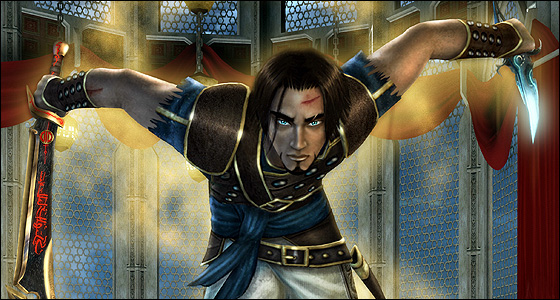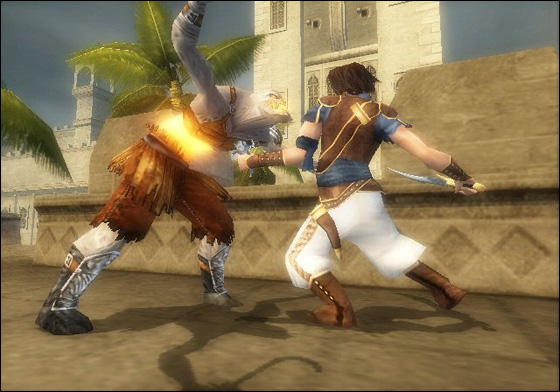Balancing Western and Middle Eastern Cultures in Prince of Persia: Sands of Time
September 2nd, 2009

(This is a canned GameSetWatch column. You might notice that I’ve moved from the biweekly format. I hope you enjoy.)
Middle Eastern folk tales have for centuries held a prominent place in the world’s rich thematic of story telling. The earlier stories began their lives existing within the fragility of spoken language. If a story could garnered enough interest within a community it would spread with a pervasive force to neighbouring communities, hoping from township to township. Each step would see the tale take on new forms as cultural influences push and pull various plot points. One Thousand and One Nights is a prime example of such a story, a culmination of Arabic, Persian, Indian and Egyptian traditions and beliefs all rolled into the one collection of fables.
Print would soon come to immortalize these stories and with cross national trade taking place it wouldn’t be long before what originated as a series of stories spread among a few townships became a larger part of the world’s global culture. These stories, now translated, compiled into books and distributed globally would become the foundation for western adaptions into film and then animation. Arabian Nights (1942) The Seventh Voyage of Sinbad (1958) and Aladdin (1992) represent some of the most significant western adaptions of prominent Middle Eastern folk tales. In this industry though, we have Prince of Persia, a game which I would argue has an elusive purity in large part due to the rich palette it draws from.
When creating a piece of media derived from such a rich cultural background it’s important to find a comfortable middle ground which both respects the source culture and the intended audience. After all, you want the audience to enjoy the media, yet at the same time your inspiration contains the beliefs and ideologies of other people, you’d be a criminal to trample all over that by misrepresenting their values.
The Prince of Persia series does partake in its fair share of trampling and a fair share positive representation too. Context is also important, so I say it’s well worth having a look at how Prince of Persia: Sands of Time (it’s my favourite) balances either end.

(The texts are symbolic of the culture, therefore I should clarify by saying that it’s not so important that the new piece of media abides by the original text as so much as to be respectful of intents and cultural differences.)
Generally speaking, Sands of Time is similar to many modern films inspired by the Middle East. Sands of Time is an innocent stab at a popular theme mixed with western ideals and influence. Just like other western attempts it very much takes the extremely oriental perspective, treating the subject matter as the weird and wonderful, yet never quite normal — like us. There’s always a distance to be drawn. The narrative, characters and setting are therefore all set within the appropriate cultural context of western expectations and there’s nothing too culturally offensive so to speak. It might be clichéd but even in this sense, the game deserves major kudos for at least not misrepresenting the culture in this post 9/11 world. Clearly the game was made with good if not a little characterized intent.
My presumption here is that by setting the game and its cast somewhere in the past all is seen as okay since after all Middle Eastern people weren’t really all that bad back then, they’re just not very good now. Taking the safe path through Persian history allows Ubisoft to avoid dealing with the aforementioned stereotypes that westerners hold against the contemporary Middle East. The game can never put modern Middle Eastern people and positive attributes in the same pool. The characters very much reflect this attitude by firmly planting themselves as traditional. If we extend our scope a little into the latest incarnation of the series we can see a contradiction in how the heavily western Prince of Persia (2008) protagonists are designed as people with modern day sensibilities, yet the Middle Eastern folk are reserved to the safe archetype of being traditional. If they’re traditional they’re even less like us and therefore that’s okay. Alas, I digress, let’s stay focused on the characters though.
Characters are very important to this conversation as they’re role models of their culture. As with the game in general, the Prince conforms to typically western tropes, maintaining enough Persian influence through appearance and accent to justify his title of Persian descent. As a partly western character he plays the role of the masculine hero in pursuit of the buxom babe – and yes the babe is suitably buxom. His warrior’s attire very much highlights this, making him ever more masculine as he loses various pieces of his clothing. There’s both quality and detriment to this approach. Portraying the somewhat Middle Eastern protagonist as a competent, albeit western, hero is no doubt positive, yet doing so by means which suppress the Middle Eastern culture is itself misleading. An ideal means would be to depict the Prince’s gradual maturation through a Middle Eastern lens by their own perceptions of heroism. This itself though is difficult within a western context, hence the foregrounded western ideologies can be forgiven as the acceptable norm.

What cannot be forgiven though is how the most Middle Eastern appearing characters in the game; the sand creatures, are depicted as barbaric and dangerous. Most of the monsters are also significantly disfigured and equipped with privative weapons as well. Of course, they’re enemies, fodder for the Prince’s blade, they should look menacing and evil. Wrapping them up in turbans, vests and traditional garbs, and layering them with a grey skin colour and possessed eyes only appeals to our underlying racist sensibilities. Ironically, the Prince’s father in which the Prince must slay early on is the most dressed up of them all.
I’ve been rather critical so far of what is for the most part standard fair in the entertainment business, so let’s look at some of the better representations. Throughout the whole trilogy the importance of water is implicitly stressed through it’s symbolism of life. The Prince drinks water to heal and save, often having to go for multiple drinks to fully refill his health bar. Sand, through the sands of time and sand creatures may also be an opposing metaphor for death.
The game also acknowledges the early conflict between India and neighbouring countries, often referencing names within the real life setting. Furthermore the narrative frequently uses terms of Indian and Muslim hierarchy such as Maharajah and Vizier. Arabic is also encrusted on the Prince’s sword.
Conclusion
The underlying connotations of Sands of Time inherently underpin typically western ideas and norms. Yet Sands of Time‘s acknowledgement and mostly positive representation of the Middle East, while flawed, should not be understated. It’s a typical byproduct of dominant western ideologies, conforming to similarly misguided adaptions which created the precedence for Prince of Persia’s overall theme. This much is to be expected though, we see the world through our own cultural lens and our entertainment is nothing more than a reflection of that.



 Game Design Companion: A Critical Analysis of Wario Land 4 - $7.99
Game Design Companion: A Critical Analysis of Wario Land 4 - $7.99 Level Design: Processes and Experiences
Level Design: Processes and Experiences Speed Boost: The Hidden Secrets Behind Arcade Racing Design - $5.99
Speed Boost: The Hidden Secrets Behind Arcade Racing Design - $5.99 Adventures in Games Analysis: Volume I - $5.99
Adventures in Games Analysis: Volume I - $5.99







